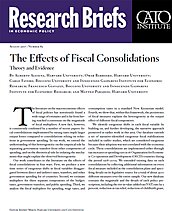Our work contributes to the literature on the effects of fiscal consolidations in four ways. First, we produce a new time series of exogenous shifts in fiscal variables disaggregated between direct and indirect taxes, transfers, and other government spending for 16 countries. Second, we estimate multipliers for three separate components of the budget: taxes, government transfers, and public spending. Third, we analyze the fiscal multipliers for spending, wage taxes, and consumption taxes in a standard New Keynesian model. Fourth, we show that, within this framework, the persistence of fiscal measures explains the heterogeneity in the output effect of different fiscal components.
We identify exogenous shifts in each fiscal variable by building on, and further developing, the narrative approach pioneered in earlier work in this area. Our database extends a set of narrative-identified exogenous fiscal stabilizations included in earlier studies, which are considered exogenous because their adoption was not correlated with the economic cycle. These consolidations are implemented either through tax increases or spending cuts in 16 Organization for Economic Co-operation and Development (OECD) countries during the period 1978–2009. We extended existing data on such consolidations by collecting additional information on every fiscal measure included in the consolidation plans and specifying details on its legislative source for a total of about 3500 different measures over the entire sample. Our new database contains the magnitude and the details of each policy prescription, including the rise in value-added tax (VAT) rate by 2 percent, reduction in tax relief, reduction of childbirth grant, 2 and cut in public employees’ salaries. We also extend the sample by identifying the consolidation episodes between 2009 and 2014—a particularly interesting period in light of the austerity plans adopted in many European countries.
After having identified exogenous fiscal measures, we organize the data into multiyear plans, that is, announcements of shifts in fiscal variables to be implemented over a horizon of several years. This is the way fiscal policy is implemented in the real world: not through isolated shifts in fiscal variables, but through legislation (in most countries through a budget voted by legislatures once a year) that includes multiyear announcements. To the extent that expectations matter, the multiyear nature of these announcements cannot be ignored. In our work we review why this is the case and use this methodology to broaden the scope of our previous analysis. We analyze three types of plans based, respectively, on cuts in government purchases and government investment, on reductions in transfers, and on increases in taxes (both direct and indirect). With few exceptions, there has been limited previous attempt at distinguishing between the effects of transfers and other forms of government spending.
We find that plans based on reductions in spending (current and investment) or reductions in transfers have broadly the same effect on output. They both cause, on average, a mild recessionary effect after one year from the start of the consolidation, but this effect starts vanishing the second year. On the other hand, tax-based adjustments cause much larger output losses than expenditure-based fiscal consolidations. Tax-based plans also have long-lasting recessionary effects: four years after the introduction of a tax-based plan worth 1 per cent of GDP, output is more than 1 percentage point lower than it would have been absent the consolidation.
In the theoretical part of the paper, we ask which mechanisms could explain these heterogeneous effects. We start from the standard New Keynesian model and include four fiscal variables: labor taxes, consumption taxes, transfers, and other government spending. We compute instantaneous multipliers in a linearized version of the model that excludes capital and assumes that the government budget is always balanced. Running comparative statics on the persistence of fiscal variables, we show that such persistence can explain the observed heterogeneity and rationalize our empirical results.
When fiscal policies are close to permanent, government spending cuts are less recessionary than tax hikes. The opposite is true if fiscal shocks are expected to quickly reverse. The behavior of the spending multiplier is consistent with prior studies, but we now evaluate tax multipliers in relation to their persistence. In contrast with standard New Keynesian models, we obtain a spending multiplier higher than one when the persistence of spending shocks is low and monetary policy does not respond to output. The persistence of fiscal shifts is a crucial aspect to explain the difference between the multipliers of each fiscal component in a fiscal stimulus, compared to a fiscal consolidation. Fiscal stimuli tend to be temporary and generate large spending multipliers. Fiscal consolidations are more permanent and generate low spending multipliers; the opposite is true for taxes. This aspect can help reconcile our results with the previous literature.
The fact that our theoretical results square with our empirical findings, if the persistence of fiscal measures is high, should not come as a surprise. In our empirical analysis, fiscal consolidation shocks are once-and-for-all legislative fiscal changes. In the data collection we seldom encountered cases where previously implemented measures are reversed by the government. We also estimate a positive intertemporal correlation of fiscal shocks in our data, indicating that, rather than being reversed, aggregate fiscal components typically accumulate over the course of fiscal plans.
Our contribution to this literature is the simultaneous estimation of public spending, transfers, and tax multipliers during consolidation episodes in a panel of 16 OECD countries. The novelty of this work emphasizes the importance of shocks’ persistence in explaining the heterogeneous response of output to different fiscal components and shows the robustness of these mechanisms across a wide range of economic environments.
NOTE:
This research brief is based on Alberto Alesina, Omar Barbiero, Carlo Favero, Francesco Giavazzi, and Matteo Paradisi, “The Effects of Fiscal Consolidations: Theory and Evidence,” NBER Working Paper 23385, May 2017, http://www.nber.org/papers/ w23385.
